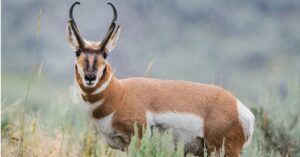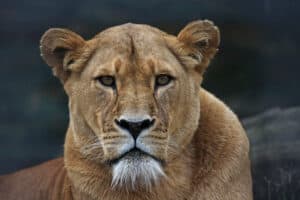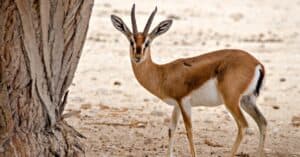Antelope are well known for their graceful appearance and impressive horns. However, when we think of antelope, it’s easy to assume that they are a specific group of animals. In fact, “antelope” is a term used to describe members of the Bovidae family that are not sheep, cows, or goats. Although antelope are most often associated with being African animals, many also live in Asia and parts of Europe. There are 91 species of antelope, and they are in a wide range of sizes. We’ve compiled a list of the largest antelopes in the world by height. Here’s a picture preview:
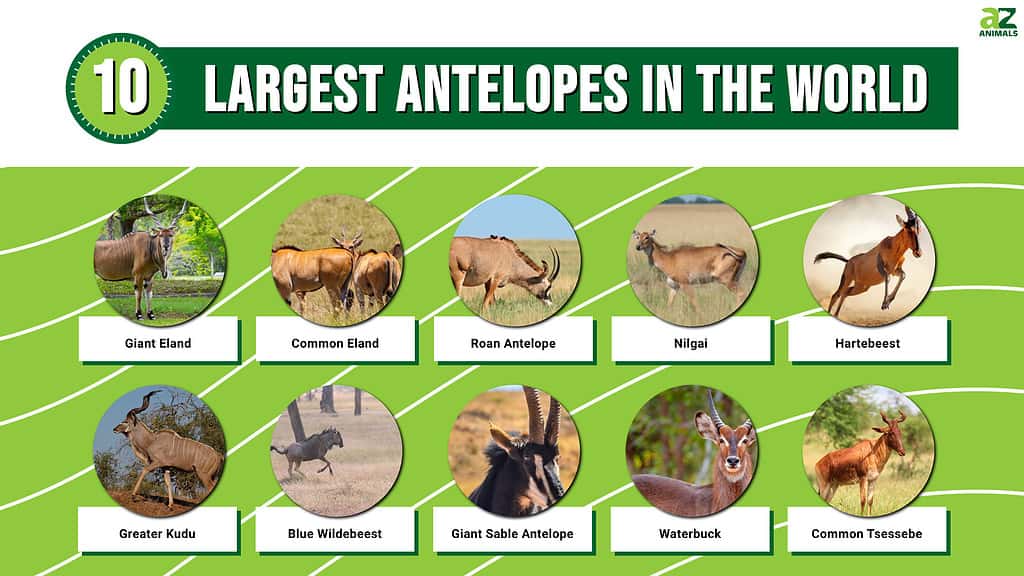
Read on for more information about these amazing animals, their appearance and their locations as well as their height!
#10 Largest Antelope: Common Tsessebe
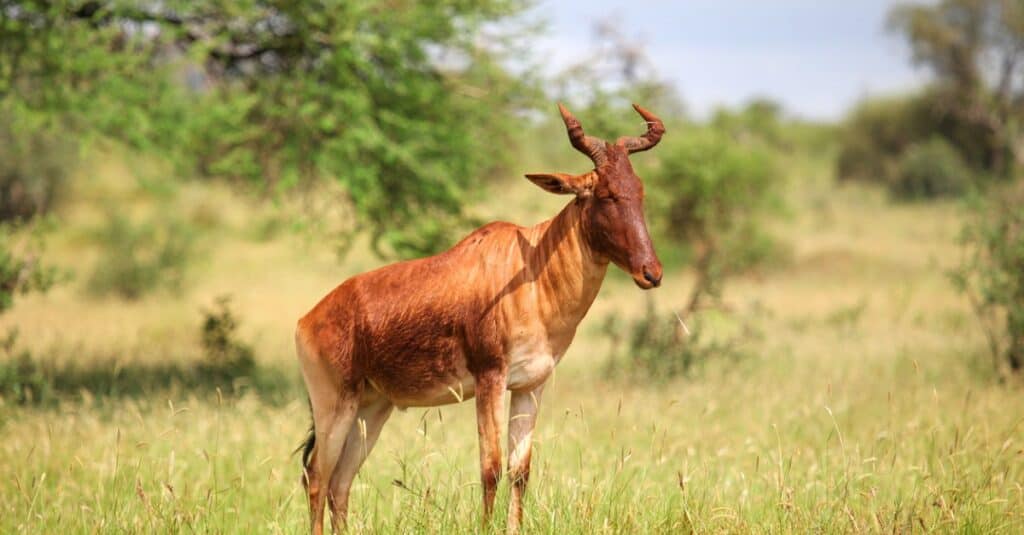
Common tsessebes have a distinctive hump at the base of their necks.
©iStock.com/DarthArt
First on the list is the common tsessebe which reaches a shoulder height of 4ft 3in. They are found in Angola, Botswana, Eswatini, Namibia, Zimbabwe, and Zambia where they prefer to live in grasslands and on open plains. Common tsessebes are large, dark brown antelopes that have a noticeable hump at the base of their necks and 16-inch long horns. Common tsessebes are social antelopes and herds usually consist of around 10 females and their young. Once they reach one year old, males leave their mother’s herd and live in large bachelor herds of up to thirty bulls. Lions are the main predators of common tsessebes, although jackals and hyenas often take youngsters.
#9 Largest Antelope: Waterbuck
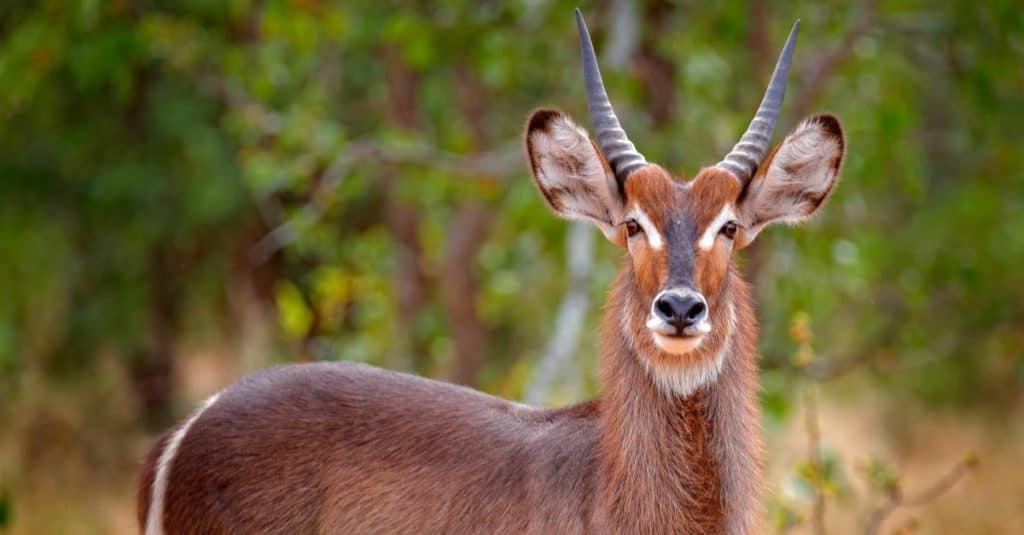
Waterbuck are distinguished by the white patches on their face, throat, and rump.
©Ondrej Prosicky/Shutterstock.com
Waterbucks are large antelopes that live across southern and eastern Africa. There are 13 recognized subspecies of waterbuck, but most are between 4 feet and 4ft 7in at the shoulder with males both taller and longer than females. Waterbuck are reddish-brown and their coats get darker as they get older. They have white muzzles, a white patch on their throat, on their rump, and inside their ears. Only males have horns, and they are particularly distinctive as they curve backward and then curve forward at the top. Waterbuck cannot cope for long without water in hot weather, so is usually found in scrubland and grasslands near rivers and lakes.
#8 Largest Antelope: Giant Sable Antelope

Critically endangered – giant sable antelopes were once thought to be extinct.
©iStock.com/Shams
Giant sable antelopes are subspecies of sable antelopes and reach 4ft 8in at the shoulder. They are critically endangered and are endemic to a region of Angola between the Cuango and Luando rivers. Giant sable antelopes are the national symbol of Angola and for a long time, it was thought that the entire population had been wiped out during the Angolan Civil War but they were rediscovered in 2004. Males are black, while females are reddish-brown, and both have white patches on their faces, rumps, and underneath their bellies. They also have impressive horns that curve backward. Males have larger horns than females and they can reach an incredible 65 inches. Lions and crocodiles are the main predators of adults, but leopards and hyenas often take calves.
#7 Largest Antelope: Blue Wildebeest
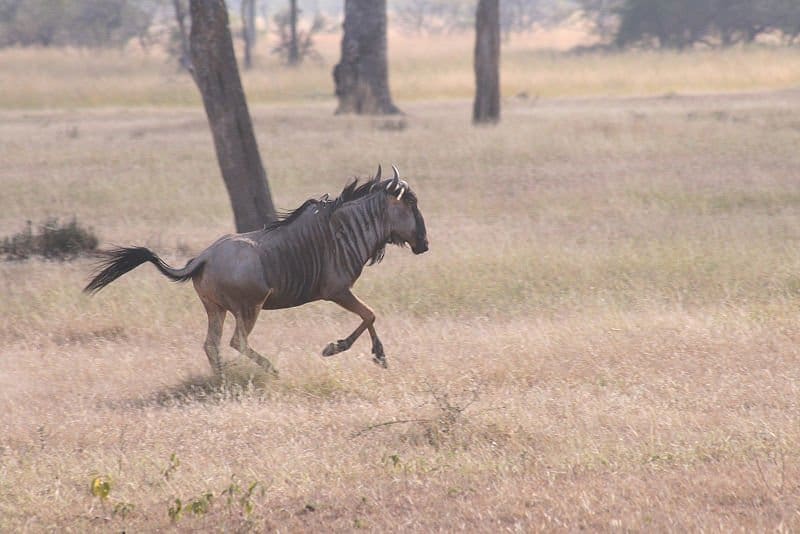
Blue wildebeests have a heavy, muscular appearance.
©Muhammad Mahdi Karim, GFDL <http://www.gnu.org/copyleft/fdl.html>, via Wikimedia Commons – License
Despite looking more like cows with their heavy appearance, blue wildebeest are antelopes. They are widespread across Africa – including Angola, Botswana, Kenya, South Africa, Swaziland, Zimbabwe, and Zambia. Blue wildebeest can reach 4ft 8in and are dark brown or grayish-brown with a large, heavy head, muscular shoulders, and a long, black tail. Both males and females have curved horns that are similar in appearance to those of a buffalo. Blue wildebeest are extremely active and agile and can even reach 50mph. However, they are a main food source for lions, cheetahs, leopards, and hyenas.
#6 Largest Antelope: Greater Kudu
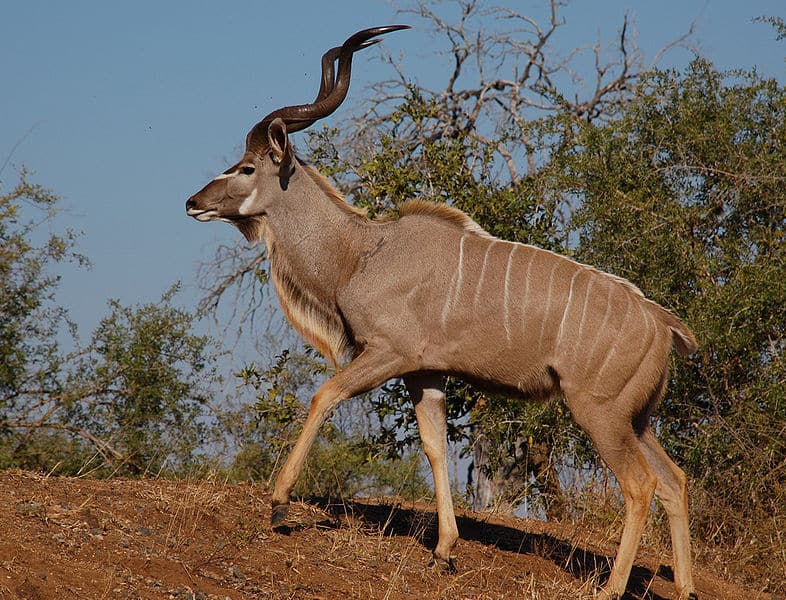
Male Greater Kudus have large, impressive horns with several twists in them.
Greater kudus are stunning antelopes that can reach 4ft 11in at the shoulder. They have long legs and are usually either brown or reddish-brown with between 4 and 12 white stripes down their bodies and a small white mark between their eyes. Males have large, impressive horns that have several twists in them, although they don’t begin to grow until the kudu is between 6 and 12 months old. Greater kudus are usually found in woodland areas in East and South Africa. They eat leaves, grass, and fruit and rarely venture out onto the open plains. Greater kudus are not particularly territorial and herds usually consist of around ten females with their young, while males are often solitary.
#5 Largest Antelope: Hartebeest
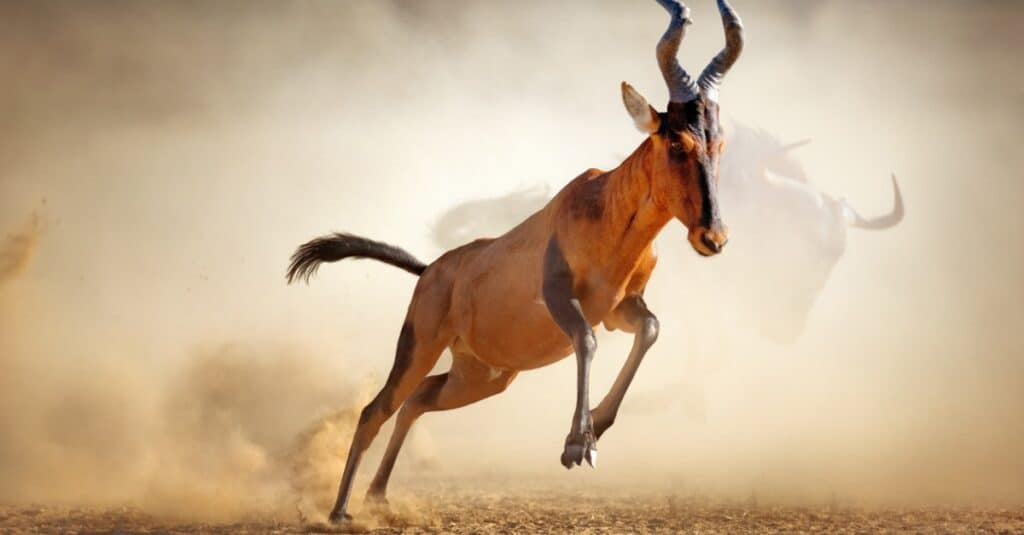
Hartebeests live in huge herds of around 300 animals.
©iStock.com/johan63
Also known as kongoni, hartebeest live in the grasslands and savannahs of sub-Saharan Africa. They were originally widespread across North Africa and the Middle East, but their range and numbers have been much reduced, in part because of hunting. There are eight recognized subspecies, and the Lelwel and Swayne’s hartebeests are endangered, while the Tora hartebeest is critically endangered. Hartebeest can reach around 4ft 11in at the shoulder and are best known for their long foreheads and horns which can curve in a range of ways, depending on the subspecies. Their bodies are brown or tan and they have black markings on their legs. Hartebeest lives in large herds of up to 300 animals and, although they are generally calm in nature, they are always alert. Lions, leopards, hyenas, African wild dogs, cheetahs, and crocodiles are all predators of hartebeest.
#4 Largest Antelope: Nilgai
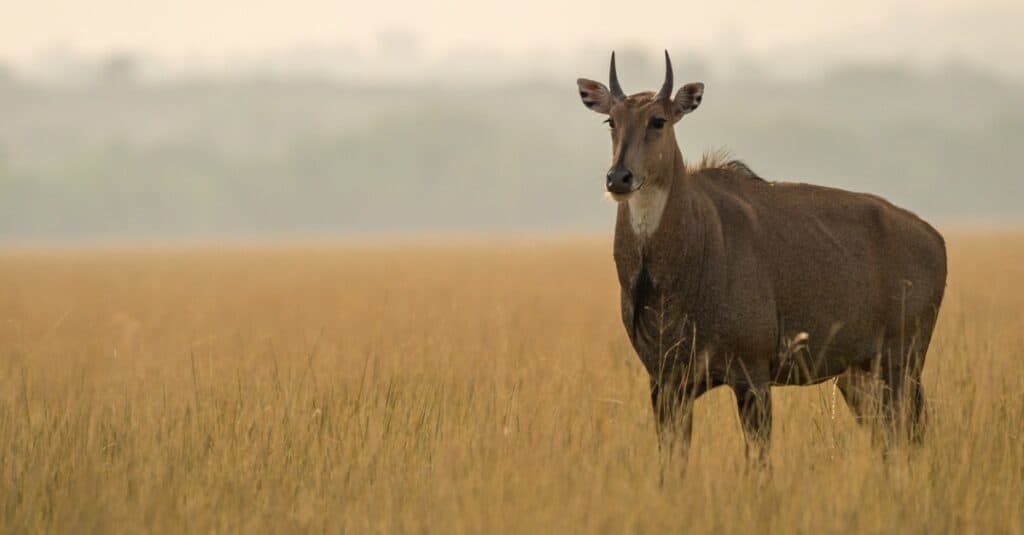
Nilgai are the largest antelopes in Asia.
©iStock.com/Sourabh Bharti
Also known as blue cows, nilgai are found in India, Nepal, and Pakistan and prefer scrub forests and grasslands. They are the largest antelope in Asia and reach 4ft 11in. Nilgai can easily be distinguished by their sturdy appearance, sloping back, and a white patch under their throats. Females are tan, while males are striking bluish-grey and have small horns. Nilgai lives in small groups of less than 10 animals with males and females separate. Although they are extremely cautious antelopes and quickly flee in the face of danger, both sexes are prone to fighting amongst themselves. Fights often involve nilgai ramming each other with their horns and pushing their necks against each other. Leopards are the main predators of nilgai, although wolves and hyenas also sometimes kill them.
#3 Largest Antelope: Roan Antelope
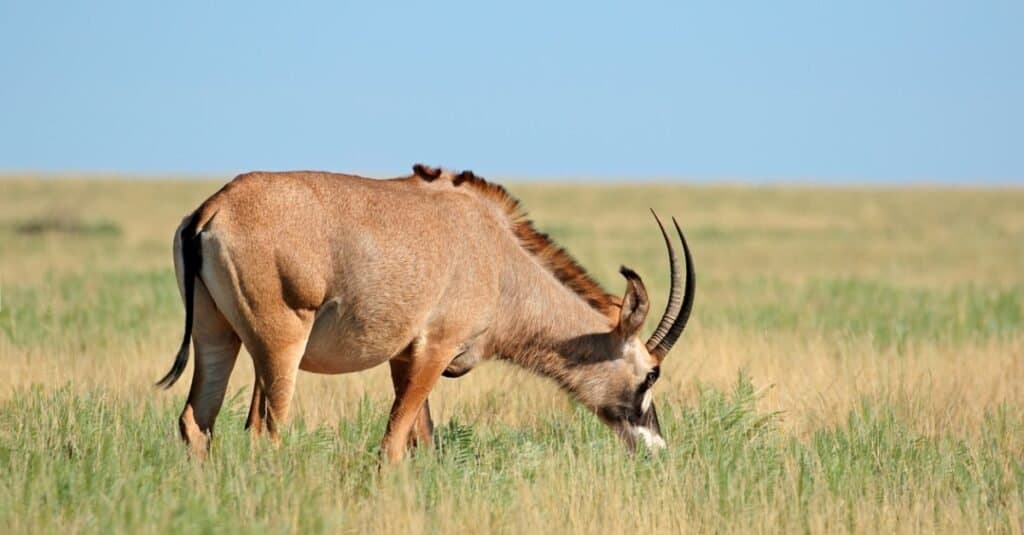
Female roan antelopes hide their young in long grass for the first few weeks of their lives.
©iStock.com/EcoPic
Roan antelope are widespread across Africa and are often confused with sable antelope. With a shoulder height of 5ft 3in, roan antelopes are easily one of the largest antelopes on the list. Roan antelopes are a reddish-brown color with lighter hair under their bellies. They also have white patches on their faces and horns which can be more than 3 feet long. Roan antelopes are found in mainly in grasslands and savannahs where they eat mid-length grasses. Roan antelopes can breed at any time of the year and females hide their young in long grass for the first few weeks after birth to so they can hide from predators and feed in solitude. Lions are their main predator, but roan antelopes can be extremely aggressive and defensive towards other predators, and so aren’t preyed on as much as other antelopes.
#2 Largest Antelope: Common Eland

Common elands can jump more than eight feet from a standstill.
©iStock.com/TT
Reaching a shoulder height of 5ft 3in, common elands come in at number two. Common elands are found in the open savannahs of East and South Africa. Females are tan in color, while males are blueish-grey. Common elands often have distinctive stripes and markings, but these differ depending on whether they are from the northernmost part of their range or not. Both males and females have horns that spiral tightly, and males also have large dewlaps underneath their chins. Although common elands are one of the slowest antelopes (only reaching 25 mph), they can jump an incredible 8ft 2in from a standstill.
#1 Largest Antelope: Giant Eland
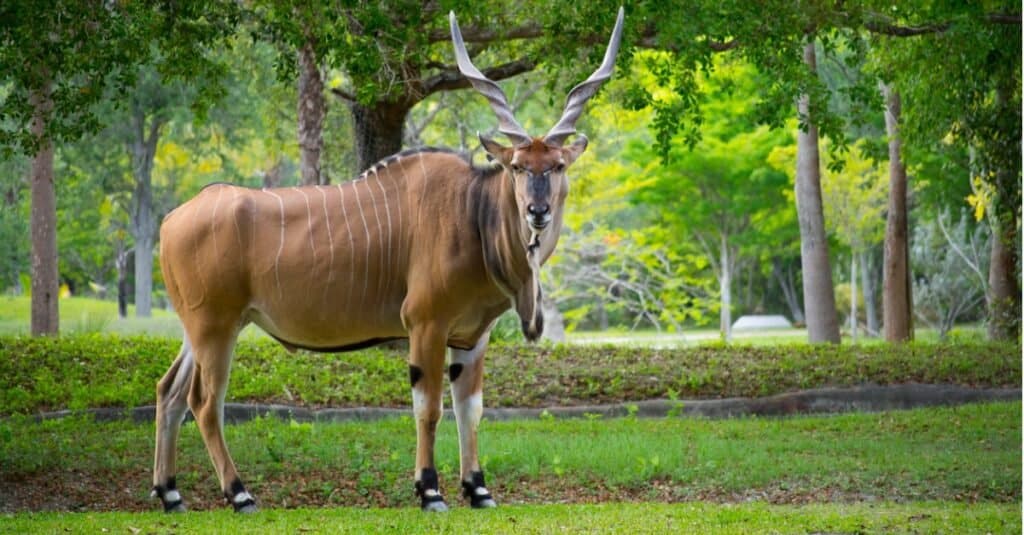
Giant elands are the largest antelopes in the world.
©iStock.com/Jose_Gonzalez_Jr
The largest antelope in the world is the giant eland. Measuring an incredible shoulder height of 6 feet and a length of more than 9 feet, they are certainly giants. Giant elands are found in open forests and savannahs in Cameroon, the Central African Republic, Chad, the Democratic Republic of the Congo, Guinea, Mali, Senegal, and South Sudan. They are reddish-brown with vertical white stripes on their bodies, and tightly spiraled horns. Giant elands are mostly nocturnal and are naturally wary. Their main form of defense against predators is speed, and their predators include lions, hyenas, and crocodiles. There are two subspecies of giant elands – western and eastern. Eastern giant elands are classed as vulnerable, while western giant elands are critically endangered. The main threats to them are hunting and habitat destruction.
Summary of the Largest Antelopes in the World:
| Rank | Antelope | Shoulder Height |
|---|---|---|
| 1 | Giant Eland | 6 feet |
| 2 | Common Eland | 5 feet, 3 inches |
| 3 | Roan Antelope | 5 feet, 3 inches |
| 4 | Nilgai | 4 feet, 11 inches |
| 5 | Hartebeest | 4 feet, 11 inches |
| 6 | Greater Kudu | 4 feet, 11 inches |
| 7 | Blue Wildebeest | 4 feet, 8 inches |
| 8 | Giant Sable Antelope | 4 feet, 8 inches |
| 9 | Waterbuck | 4 feet, 7 inches |
| 10 | Common Tsessebe | 4 feet, 3 inches |
The photo featured at the top of this post is © iStock.com/johan63
Thank you for reading! Have some feedback for us? Contact the AZ Animals editorial team.



